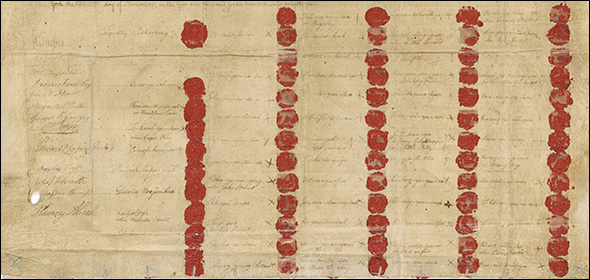Ratified Indian Treaties online
There are 374 of them in all, transferred to the National Archives from the Department of State almost a century ago.
The first is dated 14 August 1722, signed at Fort George, New York.
The last is dated 13 August 1868, signed at Washington, D.C.
In between, a tale of promises made and promises broken. A literal trail of tears, with and without the capital letters.
They are the ratified Indian Treaties, numbered 1–374, housed, according to Archivist of the United States David Ferriero, “in a specially protected area within the National Archives Building in Washington, DC, and are not pulled for use in the Central Research Room. Over 50 of the treaties are written on large sheets of parchment and several contain pictographs, drawings/maps, and wampum.”1
And Ferriero says, “Of all the things we have custody of and are responsible for—even the Charters of Freedom—I believe the Indian treaties are the most valuable documents in terms of reading the original language and the government promises, and realizing what was never delivered.”2

And, The Legal Genealogist is delighted to note, almost all are now online, available digitally, both through the National Archives Catalog and through a more convenient collection with additional tools at the Indigenous Digital Archives’ IDA Treaties Explorer.3
The Indigenous Digital Archive is a project of the Museum of Indian Arts & Culture (MIAC) in Santa Fe, New Mexico, in collaboration with the New Mexico State Library Tribal Libraries Program and the Indian Pueblo Cultural Center.
And it’s the lead mover in this online access portal, funded in large part by an anonymous donor who deserves all of our thanks.
A good place to start on the IDA Treaties Explorer website is the Guide page, which provides both print and video resources to help understand what the treaties are, their historical context, and the research possible using the Treaties Explorer site.
From there, we can move on to see the treaties themselves, or to historic maps of the lands involved in the cessions. The records and maps can be reviewed by the tribe involved and by the places impacted.
And there’s an entire Resources page with ready-made curriculum units and links to additional web and other resources.
It’s a terrific resource for all of us to use, online, and free.
Check it out: the IDA Treaties Explorer.
Cite/link to this post: Judy G. Russell, “Treatying history,” The Legal Genealogist (https://www.legalgenealogist.com/blog : posted 15 Nov 2021).
SOURCES
Image: Signatures and seals, Ratified Indian Treaty 21, Six Nations – Konondaigua, New York, 11 November 1794; Indian Treaties 1789-1869; Record Group 11, General Records of the United States Government, 1778 – 2006; U.S. National Archives, Washington, D.C.; digital images, IDA Treaties Explorer.
- David Ferriero, “National Archives and Museum of Indian Arts & Culture Share New Online Education Tool Expanding Access to Treaties between the U.S. and Native Nations,” AOTUS Blog, posted 13 Oct 2020 (https://aotus.blogs.archives.gov/ : accessed 15 Nov 2021). ↩
- Ibid. ↩
- A great big — and greatly belated — tip of the hat to my BCG colleague Karen Daniel who told me of this portal when it launched last fall… at which point it promptly fell into my own pandemic abyss. ↩



Great news!
Thanks go to Karen Daniel, who spotted this a while back (I’m just getting caught up!).
This will make it so much easier to locate these. Thanks to Karen Daniel for spotting this and to you for publicizing it.
Hello, Karen Daniel.
Great post and interesting information.
Thanks for sharing this information.
This really is a very valuable gift.
Good thing that we can now have easier access to this.
Thank you!
This will make my research of the American Indian Treaties so much easier. Big Thanks to Karen Daniel for sending you the information and to you for giving it to us.